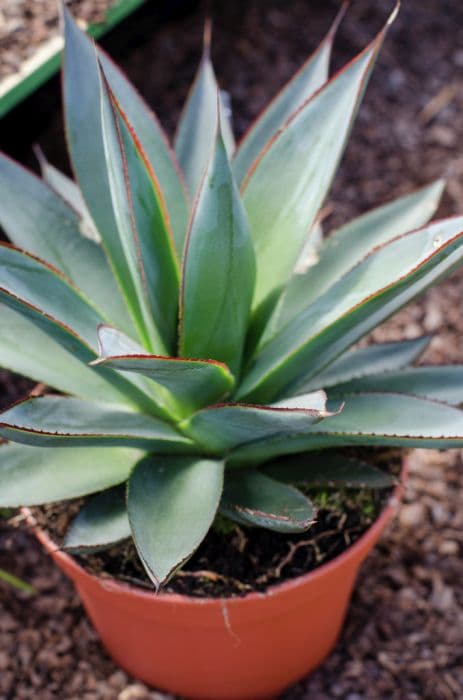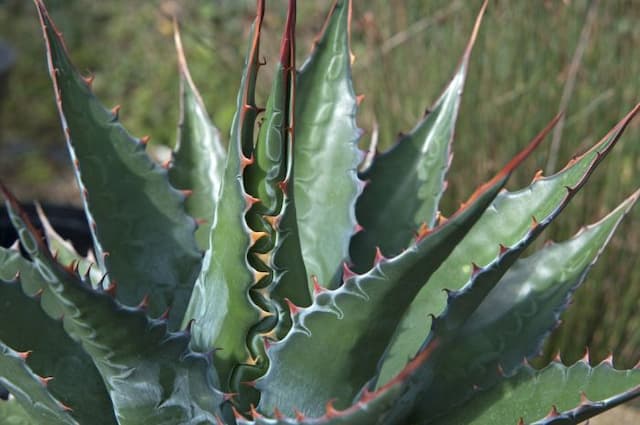Smallflower Century Plant Agave parviflora

ABOUT
The plant known as smallflower century plant is a succulent with an attractive and distinctive appearance. It has narrow leaves that form a rosette pattern. Each leaf is adorned with white, curly filaments along the edges, giving it a somewhat frilly look that can capture the eye. These fibrous decorations add to the plant's texture and overall aesthetic. The leaves themselves are a rich, green color and are generally stiff and upright with tips that may taper to a sharp point. The smallflower century plant blooms with flowers that, as the name suggests, are small in size and usually appear on a tall flowering stalk that rises above the rosette of leaves. The flowers are yellow and may have a hint of red or green. They are typically bell-shaped and hang off the sides of the flowering spike, opening to reveal the interior and sometimes attracting pollinating insects like bees and hummingbirds. The flowering event of the smallflower century plant is infrequent, occurring only after the plant has reached a certain level of maturity, which can take several years. Once the plant blooms, it typically completes its life cycle.
About this plant
 Names
NamesFamily
Asparagaceae
Synonyms
Smallflower Century Plant, Small-flower Agave
Common names
Agave parviflora.
 Toxicity
ToxicityTo humans
The smallflower century plant (Agave parviflora) is not commonly known to be toxic if ingested. However, like many agave species, its sap can cause skin irritation or allergic reactions in some people due to the presence of calcium oxalate crystals and other irritant compounds. If the sap comes into contact with skin, it may result in dermatitis or a burning sensation. There are no known severe toxic effects from ingesting this plant, but as with any non-food plant, consuming it is not advisable and could potentially cause gastrointestinal discomfort.
To pets
The smallflower century plant is generally considered non-toxic to pets, but it is not a dietary item, and ingesting it can potentially cause mild gastrointestinal upset in dogs and cats, such as vomiting or diarrhea. As with humans, the primary concern with pets is the risk of skin irritation from the plant's sap. If your pet comes into contact with the sap, they could develop dermatitis or other skin irritations. Monitoring your pet and consulting a vet if symptoms arise is recommended.
 Characteristics
CharacteristicsLife cycle
Perennials
Foliage type
Evergreen
Color of leaves
Green
Flower color
Yellow
Height
1-2 feet (0.3-0.6 meters)
Spread
1-2 feet (0.3-0.6 meters)
Plant type
Succulent
Hardiness zones
9
Native area
Mexico
Benefits
 General Benefits
General Benefits- Drought Tolerance: Agave parviflora is highly resilient in arid conditions, requiring minimal watering.
- Low Maintenance: It requires little upkeep beyond occasional watering and removal of dead leaves.
- Aesthetic Appeal: With its slender leaves and interesting white markings, the Smallflower Century Plant adds visual interest to gardens.
- Suitable for Xeriscaping: Ideal for water-conserving landscapes due to its drought resistance.
- Habitat for Wildlife: Provides nectar for pollinators such as bees and may serve as habitat for certain small animals and insects.
- Erosion Control: Its root system can help stabilize soil in erosion-prone areas.
- Longevity: Agaves live for several years, often flowering once at the end of their life cycle in a dramatic display.
- Heat Tolerance: Thrives in hot temperatures, making it perfect for warm climates.
- Succulent Collection: Popular among succulent enthusiasts for its unique appearance.
- Landscaping Variety: Offers diverse design uses, from rock gardens to borders.
- Easy Propagation: Can be propagated easily from offsets, allowing for expansion of plantings with minimal effort.
 Medical Properties
Medical Properties- Agave parviflora is not traditionally recognized for medicinal properties.
 Air-purifying Qualities
Air-purifying QualitiesThis plant is not specifically known for air purifying qualities.
 Other Uses
Other Uses- Textile Production: Agave parviflora fibers can be extracted and processed into durable threads used in weaving or making twine and ropes.
- Decorative Art: The plant's striking appearance, with its delicate white markings and compact size, makes it a popular addition to rock gardens and as a living sculpture in arid landscape designs.
- Tattoo Ink: Historically, some indigenous cultures may have used the sap or crushed leaves of agave species to create a pigment for tattoos.
- Photography: Agave parviflora can be used in floral compositions and as subjects for botanical photography due to their unique form and texture.
- Food Garnishing: Though not a common use, the flowers of Agave parviflora, being edible, can occasionally be used as an exotic garnish in high-end culinary presentations.
- Biomimicry Inspiration: The plant's efficient water storage capabilities can inspire engineers and designers looking to solve water conservation issues in arid environments.
- Historical Education: Agave parviflora can be used as an educational tool to discuss the uses of the Agave genus by indigenous peoples of its native range.
- Religious Symbolism: In certain cultures, the agave might be incorporated into religious or spiritual ceremonies as a symbol of resilience and adaptation.
- Fish Poison: In some traditional practices, compounds from certain agave plants are used to stun or kill fish, although it's not a recommended or sustainable fishing method.
- Craft Material: The dead flower stalks of Agave parviflora, being both strong and light, can be utilized in making small handicrafts or as stakes in gardening.
Interesting Facts
 Feng Shui
Feng ShuiThe Smallflower Agave is not used in Feng Shui practice.
 Zodiac Sign Compitability
Zodiac Sign CompitabilityThe Smallflower Agave is not used in astrology practice.
 Plant Symbolism
Plant Symbolism- Resilience and Adaptability: The Smallflower Century Plant, being a succulent, thrives in harsh, arid environments, symbolizing the ability to survive and adapt to challenging conditions.
- Longevity: This plant is known for its long life span, which can be a symbol of endurance and the passage of time.
- Resourcefulness: Smallflower Century Plant is highly efficient in water storage, representing the trait of making the most of available resources.
- Protection: With its tough leaves and sharp spines, the Smallflower Century Plant can symbolize the need for setting boundaries and self-defense.
- Persistence: The plant's slow but sure growth towards its once-in-a-lifetime bloom event symbolizes dedication and the importance of persisting toward one’s goals.
 Water
WaterSmallflowered agave should be watered deeply when the soil has completely dried out. In hotter climates, this may mean watering every one to two weeks, while in cooler climates, every three to four weeks may suffice. It's important to avoid overwatering, which can lead to root rot. Typically, providing about a gallon of water at each watering session should be adequate to reach the root zone without causing waterlogging. During winter, watering can be reduced significantly to once a month, or even less if the plant is outdoors in a rainy climate.
 Light
LightSmallflowered agave thrives in full sunlight conditions and should be placed in a spot where it receives at least six hours of direct sun daily. It can tolerate partial shade, but it's ideal to ensure that it gets plenty of sun for optimal growth and health. A south-facing window or a sunny spot in the garden are great spots for this agave.
 Temperature
TemperatureSmallflowered agave prefers warm temperatures and can tolerate a range from 50 to 90 degrees Fahrenheit. It is cold hardy to about 30 degrees Fahrenheit but should be protected from frost, which could damage the plant. The ideal temperature range for the smallflowered agave to thrive is between 70 to 80 degrees Fahrenheit during growing season.
 Pruning
PruningPruning smallflowered agave is generally not necessary as they maintain their shape naturally. However, if any damaged or dead leaves occur, they can be trimmed off to keep the plant looking its best. Pruning should be done with clean, sharp tools to minimize any damage to the plant. The best time for pruning is in the spring or early summer, when the plant is not in its dormant phase.
 Cleaning
CleaningNot needed
 Soil
SoilAgave parviflora, commonly known as smallflower century plant, prefers a well-draining soil mix composed of one part sand or perlite, one part compost, and one part potting soil to ensure proper drainage and aeration. The ideal soil pH for smallflower century plant is slightly acidic to neutral, ranging from 6.0 to 7.5.
 Repotting
RepottingSmallflower century plants require repotting every few years as they outgrow their pots or when the soil becomes compacted. Typically, repotting every 2 to 3 years is adequate for maintaining plant health and vigor.
 Humidity & Misting
Humidity & MistingSmallflower century plants thrive in low to moderate humidity levels and are well-suited to the typical indoor environment, making them quite adaptable to most home settings without the need for additional humidity.
 Suitable locations
Suitable locationsIndoor
Ensure bright light, minimal water, and good air flow.
Outdoor
Plant in full sun, fast-draining soil, and water sparingly.
Hardiness zone
9-11 USDA
 Life cycle
Life cycleSmallflower Agave, or Agave parviflora, begins its life cycle as a seed, which upon germination, produces a small rosette of thin, white-striped leaves with curly white fibers along the edges. The plant grows slowly, storing energy in its dense leaf rosette for several years until it is mature. Once mature, typically between 10 and 15 years, Smallflower Agave develops a tall flowering stalk, which can reach up to 4 meters in height and produces small flowers arranged in clusters that are pollinated by bats, insects, or hummingbirds. After flowering, which may take several weeks to months, seeds are produced and the parent plant often dies, completing its monocarpic cycle. The disseminated seeds give rise to new plants, continuing the species' presence in its native habitat. Occasionally, the plant may produce offsets or "pups" around its base before flowering, which can develop into new individuals, providing an additional method of propagation.
 Propogation
PropogationPropogation time
Spring to Summer
Propogation: The most popular method of propagating the Smallflower Century Plant involves the use of its offsets, which are small replicas of the parent plant that grow from its base. Propagation is ideally done during the spring or early summer, as warmer temperatures help stimulate root growth. Gardening enthusiasts remove these offsets with a clean, sharp knife, ensuring each has a portion of roots attached. After removal, it is advisable to let the offsets dry for a few days to form a callus over the cut surface, which helps prevent rot when planted. The offsets should then be planted in well-draining soil, placed in a sunny location, and watered sparingly to encourage root development.









